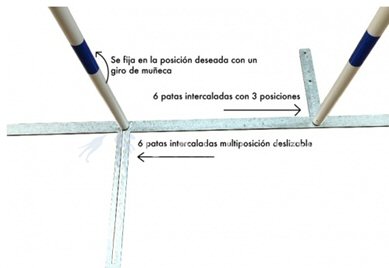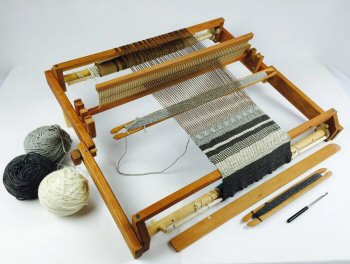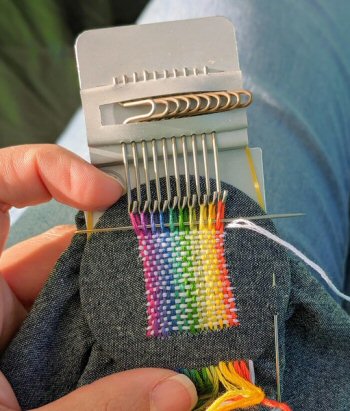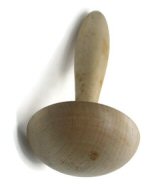How is Your Darning
Coming on?
What bee has he got
in his bonnet now...
 Alan Waddington (aka The Agility Whisperer)
has bought a new set of channel weaves from a well-known Spanish manufacturer -
the kind with the alternating weave poles which slide in and out in a channel
in a fixed foot, which acts as the stabilising bar. In all respects, they are
like a competition set of weaves. Once he had got over the pain of paying for
them, he began to think about the implications and possibilities of this design
of agility weaves. Alan Waddington (aka The Agility Whisperer)
has bought a new set of channel weaves from a well-known Spanish manufacturer -
the kind with the alternating weave poles which slide in and out in a channel
in a fixed foot, which acts as the stabilising bar. In all respects, they are
like a competition set of weaves. Once he had got over the pain of paying for
them, he began to think about the implications and possibilities of this design
of agility weaves.
Over
the years, there have been many articles and comments about the use of weaves in
dog agility. Some handlers and owners hold strong views about their safety and
the possibility of dogs getting spinal problems from their use. Over time, the
gap between poles has been widened to make this element of an agility test,
easier, particularly for larger dogs. I do not know enough about dog physiology
to offer an opinion on whether it is good or bad for it to do weaves.
The
light bulb which came on in my brain was about doing 'weaving' differently.
 Weaving
v. darning Weaving
v. darning
First
of all, let me make one thing clear. The term 'weaves' is a misnomer. In the
textile weaving process, the 'warp' threads move up and down to allow the
shuttle with the 'weft' thread to shoot through in a straight line to create the
pattern and the finished cloth.
In dog
agility, the 'warp' strands are the poles which are not offset. The dog is the
'shuttle.' Obviously, it cannot run in a straight line without getting a headache by banging
into the poles.
So, if it is not weaving, then what is the process of getting
round the poles? My contention is that it is darning.
If you
are aged under 60, you probably have no idea what darning is.
Back in the good
old / bad old days -before our throwaway society - socks, jumpers, cardigans and
other woollen garments used to be mended and put back into use. The main areas
were heels and toes on socks and elbows on upper body garments. If you were
lucky, the wool used for darning was a reasonable match for the garment being
mended.
 Another garment which used to be darned was
the woollen swimming costume. Another garment which used to be darned was
the woollen swimming costume.
What!
I kid you not.
We used to wear woollen swimming costumes. The weight used
to increase by about five or six times when they got wet and they felt as if
they would drag you to the bottom, always assuming that they did not fall off
first. I hate to think what a full costume, worn by a woman, was like. The men's
trunks were bad enough.
Anyway, enough of that, except to say that the needle
and wool did an under and over trajectory across the area to be mended, exactly
like the movement of the dog going through the poles.
 The
darning process was aided by using wooden mushrooms or eggs, to make a framework
for the repair. I am reliably informed, that the items in the photos attached,
were used for this purpose and are not objects from a 1920s equivalent of an
Anne Summers' catalogue! The
darning process was aided by using wooden mushrooms or eggs, to make a framework
for the repair. I am reliably informed, that the items in the photos attached,
were used for this purpose and are not objects from a 1920s equivalent of an
Anne Summers' catalogue!
Okay,
enough of that. Let's keep a modicum of decorum and get back to my light bulb
moment.
Why do weave poles have to be in a straight line?
If they are offset, we
might get away from some of the criticisms about the safety of the dog. With
properly designed, adjustable 'weaves' it is possible to have flexibility in
their setting with greater offset for the lower grade, less experienced dogs, 'tighter' settings for the more advanced and straight-line poles for the top
grades.
There
is already a precedent for making an obstacle easier for lower grades, with
judges tightening up the long jump for inexperienced dogs and widening it for
higher grades.
Right,
it is time to get back to my darning and mending, a skill rediscovered during
lock-down. Today, I might put leather patches on the elbows of my blazer.
One
final thought on the weaving or darning conundrum, before I sign off – why don't
we call the exercise slalom, like they do in lots of other countries.
Think
about it.
A message from the author...
Thanks to my faithful
readers. I love you both."
Life
in the Agility Whisperer household is very hectic at the moment. Moving to
another country, obtaining residency permits and setting up a new home and doing
all this during a post-Brexit pandemic could be considered mad!
First published 1st February 2022
|